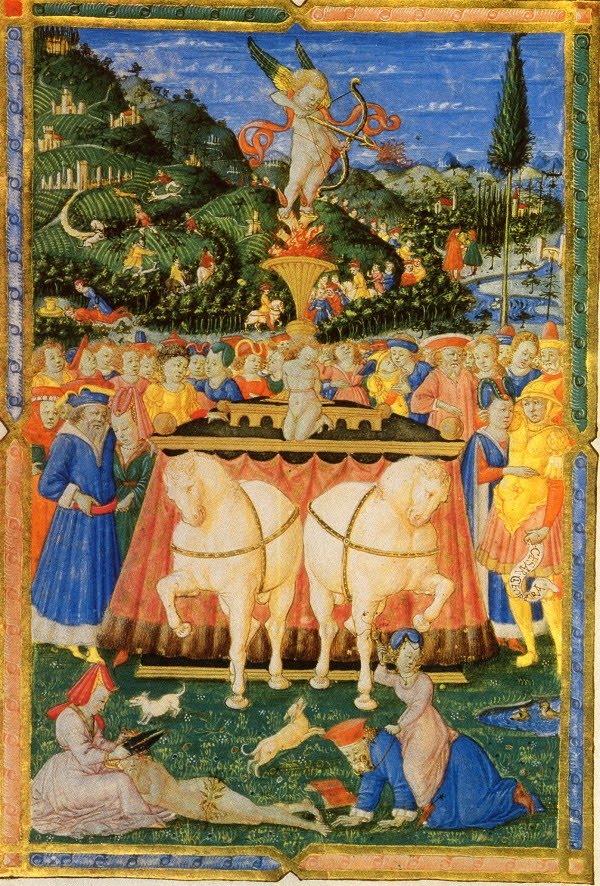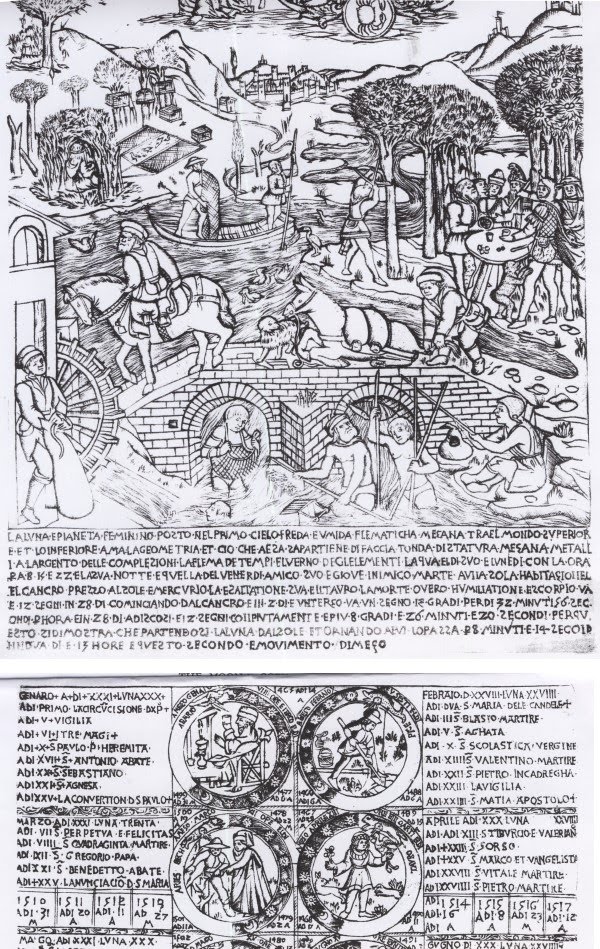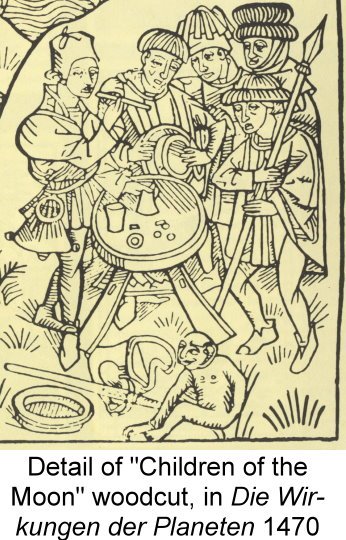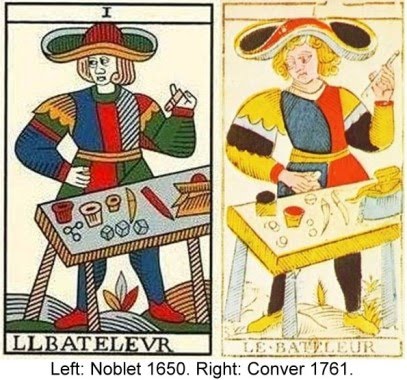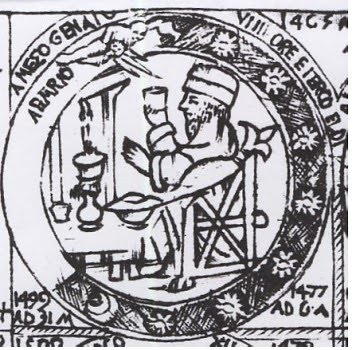Huck wrote previously,
Hind says (1938, I p. 77)Gods on triumphal chariots in 1460-64 look a little bit early for the general Trionfi development, though not impossible, it wood be more natural for the 1470's. So I've my doubts. As the devil will it, it isn't impossible, that a calendar-paper from 1465 was mixed with a later work of art ... that's just a humble and easy "forgery" by book binding, which might create "revolutionary perceptions" of conditions, which might well have been different.
. He has reproductions of the copies and the calendar, and as far as I can tell he is right.The date of the copies can be fixed as 1464-65 by the presence of a calendar plate which has always been attached to the set i the British Museum, and by size and style definitely forms part of it, and which covers the years 1465-1517.
Also, both Hind and Lambert say that "trionfi" imagery to illustrate Petrarch was standardized in the 2nd quarter of the 15th century. Here is Hind (1938, I p. 32:
Hind then asks why, although Petrarch had only one of his powers on a chariot, the artists had all six. He answers thatNo theme outside the stories of Scripture gave more frequent employment to artists and craftsmen of the fifteenth and sixteenth centuries than Petrarch's famous series of poems, the Trionfi. It is found alike in illumination, in tapestry, in the painted decoration of marriage-chests and birth-trays, in pottery and enamel, in relief sculptures of bronze, marble, or ivory, in engravings whether on metal or on wood.
About the second quarter of the fifteenth century the scheme and character of such designs became curiously fixed and uniform, within certain narrow limits of variation.
Hind cites Edward Armstrong in his "Italian Studies" (ed. Cecilia Ml Ady, London 1934, p. 100), describing "the allegorical chariots, which early formed the leading feature of the festival of S. Giovanni at Florence, reaching its artistic climax under the imaginative care of Lorenzo de' Medici.)The probable explanation is that to the ordinary Italian craftsman of the Renaissance the mere word "trionfo" as a matter of course suggested a chariot procession. He was familiar with the idea of Roman triumphs, had seen and copied them on many an ancient bas-relief, and the civic usage of his own time had revived something like them in innumerable street processions and public shows and pageants.
On the next page Hind cites examples from the 1440-1460:
The "present series" is a series of six engraved triumphs that Hind dates 1460-1470. These early Triumphs, as well as another series of six on one plate, are quite interesting from a tarot history perspective, as are the series on the planets themselves. As Hind notes, they have a wealth of detail missing from the later engravings. I have not seen any of these three series on the Web or in tarot books; but Huck would know better than I. I will post the "Triumph of Love" on the "Mantegna" thread. Since they are long before any festivals in 1475, I'm not sure they belong here. Right now I want to continue making the point, ad nauseum, about how early the iconography of the Triumphs developed in Florentine art.For the various cassone paintings representing the Triumphs of Petrarch, the student should refer to V. Massena, Prince d'Essling, and Eugene Muntz, Petrarque, ses etudes d'art, son influence sur les artistes (Paris 1902) and Paul Schubring, Cassoni: Truhen und Truhenbilder der Italienischen Fruhrenaissance Leipzig 1923. The most important of these pictures between 1440 and 1450 are Four Triumphs (Love, Death, Fame and Divinity) in the Uffizi, No. 198 (by the so-called Cassone Master, about 1440) (Schubring 208-211; and plate xlv); another Four Triumphs (Love, Chastity, Death and Fame) at Siena (Nos. 768-771, Schubring 213-216); and the Six Triumphs on two panels, by Pesellino, in the Gardner Collection, Boston (Schubring 266, 267 and pl. lx); these all precede the present series of engravings by about a decade.
Lambert often disagrees with Hind. But on this point she plagiarizes him (p. 114:
My translation: Petrarch (1304-1374) wrote The Triumphs in 1352 or after. The manuscript was published in Rome in 1471 or after, but the poem was well known before this date. Among the works of Petrarch, it is the one that inspired artists of the XVth and the XVIth centuries the most. This figurative theme seems to have developed in the Florentine environment during the second quarter of the XVth century. The iconography derives from the taste of the Renaissance for antique triumphs, known from bas-reliefs. Holidays profane and religious took for models these triumphant processions, where allegorical figures raised on cars symbolized triumph, victory. Illuminations, paintings tapestries, ceramics, enamels, bas-reliefs of bronze, marble or ivory, birth and marriage chests, engravings on copperplate and wood reproduced them, offering a very free interpretation of Petrarch's poem, even departing from it sometimes. Figurative arts presented for every triumph a personified allegory, on top of a car pulled in harness by symbolic animals and accompanied by personnages.Pétrarch (1304-1374) écrivit Les Triomphes[ à partir de 1352. Le manuscrit fut édité à Rome en 1471, mais la poème était très connu avant cette date. Parmi les oevres de Pétrarch, c'est celle-ci qui inspira le plus les artistes du XVe et du XVie siècles. Cette thématique figurative semble s'être développée dans le milieu florentin au cours du second quart du xve siècle. L'iconographie dérive du goût de la Renaissance pour les triomphes antiques, connus par les bas-reliefs. Les fêtes profanes et religiieus prenaient pour modêles ces processions triomphales, où des figures allégoriques montées sur des chars symbolisaient le triomphe, la victoire. Enluminures, peintures, tapisseries, céramiques, émaux, bas-relief en bronze, marbre ou ivoire, décors de coiffres de naissance et de mariage, gravures sur cuivre et sur bois les reproduisaient, offrant une interprétation très libre du poème de Pétrarch. selon éloignment même parfois. Les arts figuratifs ont présenté pour chaque triomphe une allégorie personnifiée, debout sur un char tiré par un attelage d'animaux symboliques, accompagnée de personnages.
I have no pictures of examples from 1440-1450, but here is a miniature from a book dated 18 February 1456 (Florentine style), which apparently is 1457 in our calendar. (So the year ended in February?) This is according to the book The Painted Page, pp.134 (for 1457) and 136 (for 1456). The illumination itself is on p. 135.
